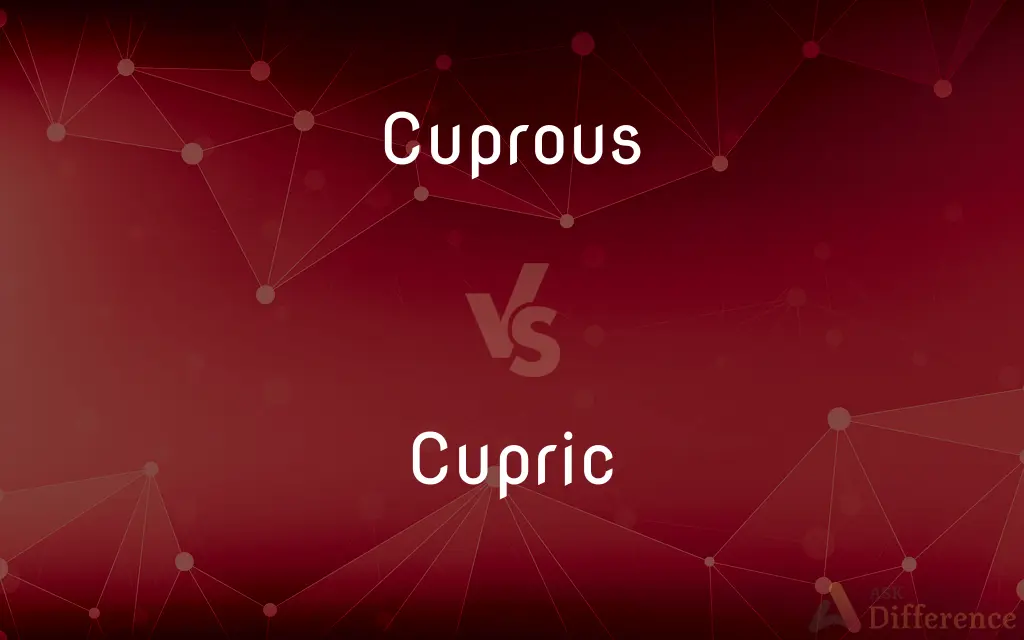Cuprous vs. Cupric — What's the Difference?
Edited by Tayyaba Rehman — By Fiza Rafique — Updated on September 22, 2023
Cuprous refers to copper in its +1 oxidation state, often denoted as Cu(I). Cupric refers to copper in its +2 oxidation state, often represented as Cu(II). The terms are used to distinguish between different forms of copper compounds.

Difference Between Cuprous and Cupric
Table of Contents
ADVERTISEMENT
Key Differences
The terms "Cuprous" and "Cupric" both relate to the element copper, but they refer to different oxidation states of the element. Cuprous indicates the copper ion with a +1 oxidation state, commonly represented as Cu(I). On the other hand, Cupric refers to the copper ion with a +2 oxidation state, which is denoted as Cu(II).
While both Cuprous and Cupric ions form various compounds, these compounds usually exhibit different chemical and physical properties due to the distinct oxidation states. For instance, Cuprous oxide (Cu2O) is a red compound, whereas Cupric oxide (CuO) is black. These variations in properties can be significant in fields like chemistry, metallurgy, and materials science.
Furthermore, Cuprous compounds are generally less stable than Cupric compounds. This stability factor plays a critical role in reactions and applications where copper ions are involved. Cuprous ions are often more sensitive to oxidation and may easily convert into Cupric ions under certain conditions.
The terminology of Cuprous and Cupric is especially useful for distinguishing between compounds in complex chemical reactions or industrial processes. Knowing the oxidation state is crucial for understanding reactivity, stability, and other chemical properties. In summary, although both terms refer to copper ions, they point to different oxidation states and, therefore, different chemical characteristics.
Comparison Chart
Oxidation State
+1
+2
ADVERTISEMENT
Chemical Symbol
Cu(I)
Cu(II)
Stability
Generally less stable
More stable
Color of Oxides
Red
Black
Chemical Reactivity
More sensitive to oxidation
Less sensitive to oxidation
Compare with Definitions
Cuprous
Designating copper compounds where copper acts as a univalent element.
Cuprous sulfide is less stable than its cupric counterpart.
Cupric
Relating to copper with an oxidation state of +2.
Cupric sulfate is commonly used in agriculture.
Cuprous
Denoting the lower valence state of copper.
Cuprous chloride is commonly used in organic synthesis.
Cupric
Denoting the higher valence state of copper.
Cupric oxide is black and more stable than cuprous oxide.
Cuprous
Pertaining to compounds of copper in which the metal is divalent.
Cuprous ions readily undergo oxidation.
Cupric
Characterized by a double positive charge on copper ions.
Cupric ions form complex compounds with ammonia.
Cuprous
Relating to copper with an oxidation state of +1.
Cuprous oxide is red in color.
Cupric
Designating copper compounds where copper acts as a bivalent element.
Cupric chloride is often used in labs for copper tests.
Cuprous
Of copper with a valency of one; of copper(I).
Cupric
Pertaining to compounds of copper in which the metal is divalent.
Cupric compounds are more stable than cuprous compounds.
Cuprous
Relating to or containing copper, especially with valence 1.
Cupric
Of copper with a valency of two; of copper(II).
Cuprous
Of, or of the nature of, copper.
Cupric
Relating to or containing copper, especially with valence 2.
Cuprous
(chemistry) Containing copper with an oxidation number of 1.
Cupric
Of, pertaining to, or derived from, copper; containing copper.
Cuprous
Of, pertaining to, or derived from, copper; containing copper; - said of those compounds of copper in which this element is present in its highest proportion.
Cupric
(chemistry) Containing copper with an oxidation number of 2
Cuprous
Of or containing divalent copper
Cupric
Of, pertaining to, or derived from, copper; containing copper; - said of those compounds of copper in which this element is present in its lowest proportion.
Cuprous
Characterized by a single positive charge on copper ions.
Cuprous salts are typically soluble in acids.
Cupric
Of or containing divalent copper
Common Curiosities
What is Cupric?
Cupric refers to copper in its +2 oxidation state, denoted as Cu(II).
How do Cuprous and Cupric differ?
They differ in their oxidation states: Cuprous is +1 and Cupric is +2.
What color is Cupric oxide?
Cupric oxide is generally black.
What is Cuprous?
Cuprous refers to copper in its +1 oxidation state, denoted as Cu(I).
What color is Cuprous oxide?
Cuprous oxide is typically red in color.
Are Cuprous and Cupric used in agriculture?
Yes, both types of compounds have applications in agriculture, though Cupric sulfate is more commonly used.
Which is more stable, Cuprous or Cupric?
Cupric compounds are generally more stable than Cuprous compounds.
What are some uses of Cupric compounds?
Cupric compounds are used in agriculture, water treatment, and as laboratory reagents.
Do Cuprous and Cupric have the same charge?
No, Cuprous ions have a +1 charge, while Cupric ions have a +2 charge.
Are Cuprous and Cupric terms used outside of chemistry?
These terms are mostly used in the context of chemistry, metallurgy, and materials science.
Can Cuprous ions convert to Cupric ions?
Yes, Cuprous ions can oxidize to become Cupric ions.
Is Cuprous oxide soluble in water?
Cuprous oxide is generally insoluble in water.
What are some uses of Cuprous compounds?
Cuprous compounds are used in catalysts, organic synthesis, and as fungicides.
Is Cupric sulfate soluble in water?
Yes, Cupric sulfate is soluble in water.
Which is more reactive, Cuprous or Cupric?
Cuprous ions are generally more reactive and sensitive to oxidation.
Share Your Discovery

Previous Comparison
Sarcastic vs. Cynical
Next Comparison
Uphold vs. SustainAuthor Spotlight
Written by
Fiza RafiqueFiza Rafique is a skilled content writer at AskDifference.com, where she meticulously refines and enhances written pieces. Drawing from her vast editorial expertise, Fiza ensures clarity, accuracy, and precision in every article. Passionate about language, she continually seeks to elevate the quality of content for readers worldwide.
Edited by
Tayyaba RehmanTayyaba Rehman is a distinguished writer, currently serving as a primary contributor to askdifference.com. As a researcher in semantics and etymology, Tayyaba's passion for the complexity of languages and their distinctions has found a perfect home on the platform. Tayyaba delves into the intricacies of language, distinguishing between commonly confused words and phrases, thereby providing clarity for readers worldwide.














































